Transform Your Sanctuary: The Ultimate Guide to Stylish Neutral Bedroom Colors
Your bedroom is far more than just a place to sleep. It’s a personal sanctuary, a versatile space where you can unwind, recharge, pursue hobbies, connect with loved ones, or even tackle a bit of work in peace. It’s your private haven, a refuge from the outside world where you can truly be yourself.
Given its profound importance, the colors you choose for your bedroom walls play a pivotal role in shaping its atmosphere. While personal preference is always key, opting for neutral colors is often an excellent choice, especially for a space dedicated to relaxation, rest, and comfort. These subtle hues possess an inherent calming effect, contributing to a tranquil environment that promotes peace of mind and better sleep quality.
This comprehensive guide delves into the current trends in neutral colors for bedroom usage. We’ll explore why these timeless shades remain a popular choice among interior designers and homeowners alike, and how you can leverage them to create a beautifully serene and stylish bedroom that truly reflects your personal aesthetic.
Understanding Neutral Colors and Their Enduring Appeal
At their core, neutral colors are foundational hues that serve as a sophisticated backdrop, allowing other elements within a room to take center stage. They encompass a spectrum of shades including classic white, soft cream, versatile beige, warm taupe, elegant gray, rich brown, and even sophisticated black. What makes these colors truly fascinating is their inherent complexity: each neutral possesses subtle underlying hues that shift and transform under different lighting conditions, adding depth and character to a space without being overwhelming.
Selecting the perfect color for your bedroom involves several important considerations, such as the room’s size and shape, the amount of natural light it receives, and its directional orientation. The right color choice can dramatically alter the perception of a room, making it feel larger, warmer, or more inviting. Neutral colors have consistently held their ground as a favorite in interior design due to their unparalleled versatility and timeless elegance. They transcend fleeting trends, ensuring your bedroom remains chic and appealing for years to come. Let’s explore some of the most current and inspiring trends for incorporating neutral colors into your bedroom design.
Why Choose Neutral Colors for Your Bedroom?
The choice of a bedroom color palette significantly influences your mood, sleep quality, and overall sense of well-being. Neutral colors offer a multitude of benefits that make them ideal for creating a peaceful and restorative sanctuary:
- Calming and Relaxing Atmosphere: Neutral shades are inherently soothing. Unlike vibrant colors that can stimulate, neutrals promote a sense of calm and tranquility, making it easier to unwind after a long day and drift off to sleep.
- Timeless Elegance: Neutrals never go out of style. They provide a classic foundation that remains sophisticated and elegant regardless of changing design fads, ensuring your bedroom always feels fresh and modern.
- Unmatched Versatility: These colors are incredibly adaptable. They serve as a perfect canvas for any design aesthetic, whether you prefer minimalist, bohemian, modern, rustic, or traditional styles.
- Easy to Decorate and Re-decorate: With a neutral backdrop, you have endless possibilities for furniture, textiles, and accessories. Want to change your look? Simply swap out your throw pillows, artwork, or bedding, and your room will feel entirely new without needing a repaint.
- Promotes Better Sleep: Studies suggest that calming colors in the bedroom can contribute to a more restful night’s sleep. Neutrals help to reduce visual clutter and mental stimulation, fostering an environment conducive to relaxation.
- Creates a Sense of Spaciousness: Lighter neutral tones, particularly whites, creams, and light grays, can make a bedroom feel larger, airier, and more open, which is especially beneficial for smaller spaces.
- Highlights Architectural Features and Textures: By keeping the wall color subdued, neutrals allow architectural details, unique furniture pieces, or intricate textures in your bedding and rugs to truly shine.
1. Traditional Neutral Colors: Warmth and Sophistication
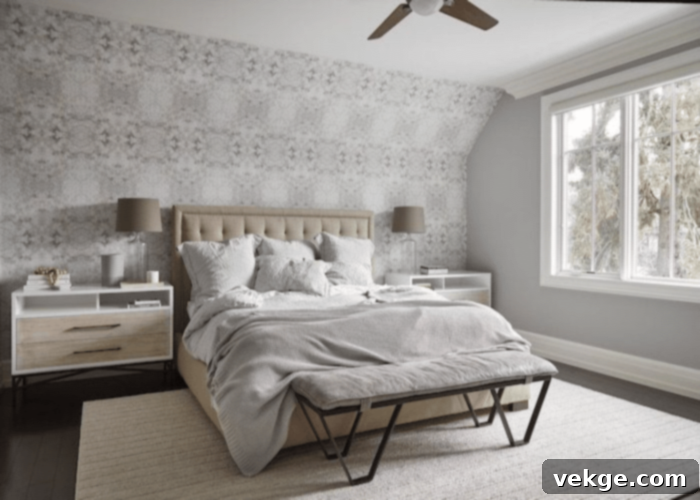
Traditional neutral colors are a perennial favorite in interior design, offering a sense of enduring elegance and comforting warmth to any bedroom. Shades like off-white, soft ivory, creamy beige, and light taupe instantly create an inviting and sophisticated atmosphere. These colors are far from boring; instead, they provide a serene backdrop that enhances every other element in the room.
To prevent these gentle tones from appearing “washed out,” consider incorporating furniture pieces or decorative accents in solid, complementary colors. A rich wooden headboard, a deep charcoal throw, or even vibrant green plants can ground the space and allow the nuanced beauty of the neutral walls to truly stand out. This approach creates a balanced visual interest without overwhelming the senses. Alternatively, you can embrace a minimalist style, letting the clean lines and subtle textures of your neutral palette speak for themselves, resulting in a bedroom that feels both serene and incredibly chic.
As depicted in the image above, combining a few different neutral shades within the same space can create a cohesive and harmonious look. The interplay of various beiges, creams, and grays adds depth and dimension, proving that neutral colors are not only soothing and versatile but also wonderfully dynamic and far from mundane.
2. Contrasting Neutral Colors: Drama and Depth
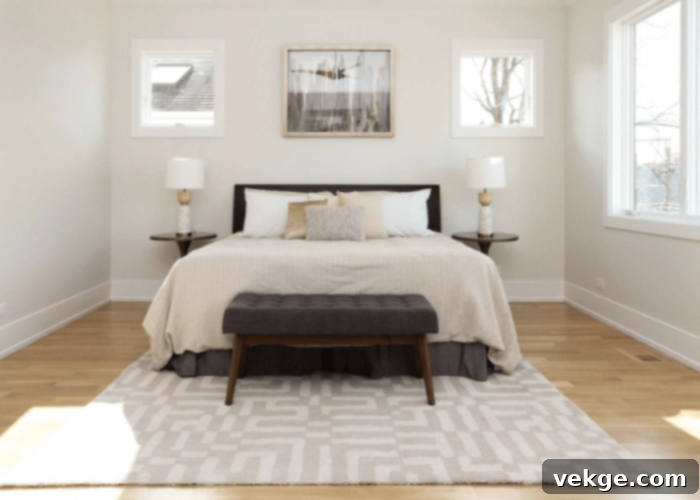
While much of interior design focuses on complementary color schemes, the strategic use of contrasting neutrals can introduce a profound sense of depth and sophisticated drama to your bedroom. You don’t always need vibrant reds, blues, or greens to create impact. Instead, consider the powerful interplay of darker neutral tones like deep charcoal gray, rich chocolate brown, or classic black against lighter neutrals such as crisp white or soft ivory.
These darker neutrals are far from being limited to specific seasons or themes. A timeless black and white pairing, for instance, is a quintessential design choice that exudes elegance and refinement, whether in fashion or home decor. This high-contrast combination creates a striking visual statement that is both bold and remarkably sophisticated. In the example image, the confident use of solid black and white elements transforms the room into a space that feels both romantic and undeniably elegant, proving that contrast within the neutral spectrum can be incredibly powerful.
To successfully implement contrasting neutrals, consider how different shades can define zones within your bedroom or highlight specific features. A dark accent wall behind a pristine white bed, or black-framed artwork against a light gray wall, can create focal points and add architectural interest without introducing any “color” in the traditional sense.
3. Bright Accents and Neutral Colors: A Pop of Personality

If you’re drawn to bright and bold colors but still desire the calming foundation of a neutral bedroom, you’re in luck! Neutral backdrops are the perfect stage for vibrant accents, allowing your personality to truly shine without overwhelming the tranquil atmosphere. These pops of color can be introduced through various accessories, making it incredibly easy to update your look as your tastes evolve.
Consider adding a plush blanket, a duvet cover, or a quilt in a striking single color or featuring a lively strip of bright pattern. A stylish, colorful lamp, framed art prints bursting with vivid hues, or an assortment of fluffy throw pillows in contrasting shades are just a few of the many options available. Even a vibrant rug or a collection of brightly colored books on a bedside table can make a significant impact.
As the accompanying photo beautifully illustrates, just a few thoughtfully placed touches are enough to invigorate a neutral space. This approach allows your bedroom to feel personalized and unique, reflecting your individual tastes and quirky charm. With simple changes to accessories, you can effortlessly transform any neutral bedroom into an inviting and energetically curated space that feels uniquely yours.
4. Patterns and Neutral Colors: Texture and Visual Interest
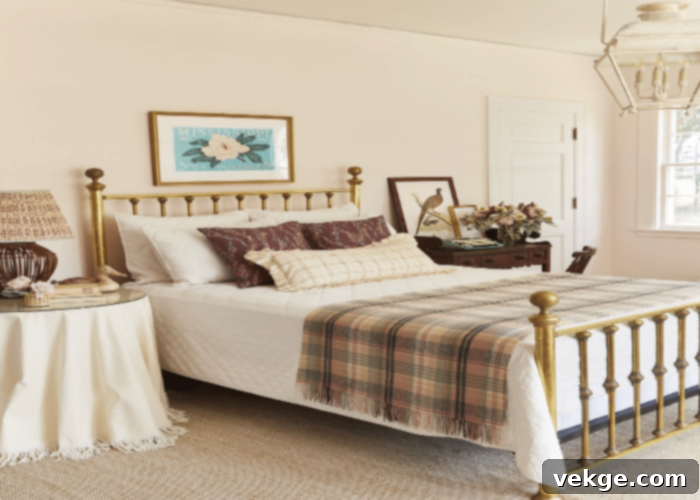
Beyond color, patterns are a crucial element in interior design, working alongside texture and sheen to add depth and character to a space. With an expansive range of patterns available in various colors and scales, you’ll be spoilt for choice when decorating your neutral bedroom. The beauty of a neutral backdrop is its ability to let patterns truly pop without making the room feel busy or overwhelming.
In the photograph provided, the subtle brown patterns seamlessly integrate with the other neutral shades in the room. Since brown itself is a versatile neutral, it creates a harmonious yet engaging visual experience. You can experiment with a myriad of designs, from bold geometric shapes to delicate floral motifs, classic dots, sophisticated stripes, or even a thoughtful mixture of different patterns. These choices can perfectly complement your neutral color scheme, adding layers of interest to your decor.
Notice how elements like the wooden side tables, the frames around the artwork, and the wooden lamp bases collectively support the overall aesthetic. These natural elements enhance the warmth and grounding effect of the neutral colors, contributing to a bedroom that automatically looks polished, elegant, and thoughtfully designed. The interplay of pattern and texture ensures that your neutral bedroom is anything but monotonous.
5. Wooden Elements and Neutral Colors: Rustic Charm and Warmth
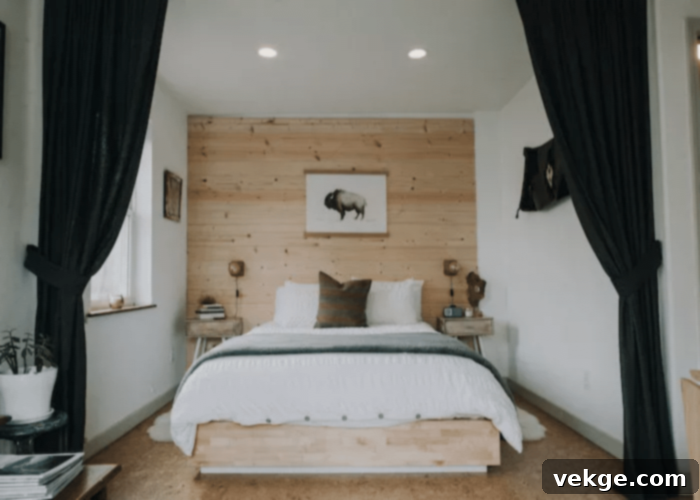
Incorporating wooden tones and elements is an exceptional design choice that should definitely be on your radar for a neutral bedroom. Wooden styles inherently offer a sense of comfort, casual elegance, and a connection to nature, while neutral colors provide soothing warmth and a welcoming ambiance. Separately, these two design approaches are wonderful; combined, they create an irresistibly inviting bedroom where you can truly shed your worries and indulge in a well-deserved moment of peace.
The rustic appeal is particularly strong and beautifully showcased in the photo above. A wooden accent wall, a robust wooden bed frame, coupled with soft black curtains, crisp white walls, pristine white bedding, and a comforting brown pillow, all come together to form a stylish and harmonious bedroom retreat. There’s an undeniable beauty in the rustic style’s inherent imperfections and natural textures, which lends an authentic, lived-in feel to your bedroom, making it both beautiful and genuinely comfortable.
Different types of wood, from light birch to dark walnut, and various finishes can further diversify your neutral palette, adding organic warmth and a sense of grounding to your personal haven.
6. Monochrome Theme and Neutral Colors: Subtle Sophistication
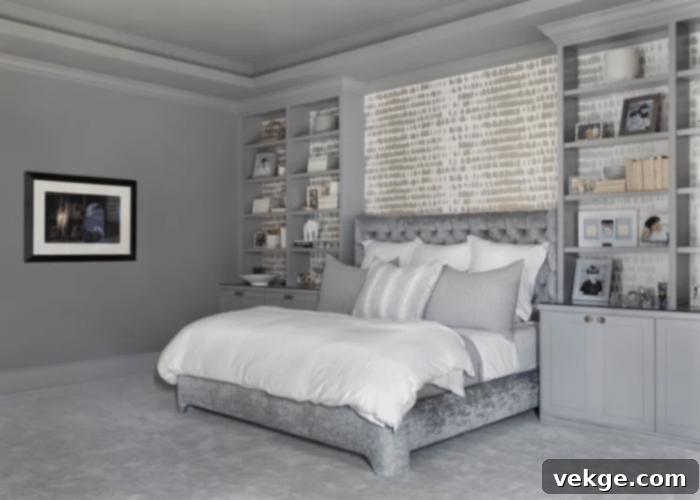
Do you find yourself drawn to one particular neutral color above all others? Perhaps a specific shade that resonates deeply with your personal style? Embracing a monochromatic theme with neutral colors can bring your bedroom to life in a surprisingly sophisticated way. Many might mistakenly perceive colors like gray as ordinary or even dull, but like all colors, when utilized correctly and thoughtfully, a single neutral hue can shine brilliantly and create an incredibly rich environment.
For instance, the accompanying photo expertly demonstrates how various shades of gray can be used in perfect harmony. From light silver to deep charcoal, the subtle transitions between tones create depth and visual interest without the need for additional colors. When executed with careful attention to detail, a monochromatic theme fosters a comfortable and remarkably elegant ambiance. The key lies in layering different textures and finishes—think matte walls against glossy accessories, or soft linen bedding paired with a chunky knit throw—to add dimension and warmth.
With just a few smart decorating tips and an eye for subtle variation, you can easily achieve a stunningly styled monochromatic bedroom that feels both cohesive and utterly serene.
Practical Tips for Choosing Your Perfect Neutral Bedroom Palette
While the allure of neutral colors is clear, selecting the *right* neutrals for your specific bedroom requires a bit of thoughtful consideration. Here are some practical tips to guide you:
- Assess Natural Light: The amount and direction of natural light in your bedroom dramatically affect how colors appear. North-facing rooms often have cooler, indirect light, which can make cool grays feel stark. Warm neutrals like cream or beige can balance this. South-facing rooms receive abundant warm light, allowing both warm and cool neutrals to thrive.
- Consider Room Size: Lighter neutrals (whites, light grays, creams) can make smaller bedrooms feel more expansive and airy. Darker neutrals (charcoal, deep taupe) can add coziness and sophistication to larger rooms, or create a dramatic accent wall.
- Personal Style and Existing Furniture: Take stock of your current furniture and decor. Do you have warm-toned wood furniture or cooler metal pieces? Your neutral wall color should complement these existing elements to create a cohesive look.
- Test Paint Samples: Never commit to a paint color based solely on a small swatch. Purchase several sample pots and paint large swatches on different walls of your bedroom. Observe them throughout the day and night under varying light conditions before making your final decision.
- Layer Textures: To prevent a neutral room from feeling flat, introduce a variety of textures. Think about plush rugs, soft linen bedding, velvet throw pillows, woven baskets, or textured wallpaper. These elements add tactile interest and visual depth.
- Incorporate Greenery: Plants bring life and a touch of natural color to any neutral space. Their organic forms and vibrant green hues offer a refreshing contrast and enhance the calming atmosphere.
- Mix Warm and Cool Neutrals: Don’t be afraid to combine warm neutrals (like beige, cream, taupe) with cool neutrals (like gray, white with blue undertones). This creates a sophisticated, balanced, and dynamic palette.
Final Thoughts
Your bedroom is a truly special space, a personal retreat where every design choice should contribute to your comfort and well-being. By decorating it in your unique style and selecting colors that resonate with your personality, you craft an environment that feels authentically yours. With a vast array of designs and colors to choose from, this article has aimed to illuminate why neutral colors for bedroom walls are an exceptionally wise and rewarding consideration.
Neutral colors are anything but dull; they are just as exciting and impactful as bold colors, offering a timeless elegance and unparalleled versatility that vibrant hues simply cannot match. Do not let anyone tell you otherwise! The colors surrounding you can profoundly affect your mood, and the calming, gentle embrace of neutral tones is precisely what you need to cultivate a serene and restorative sanctuary in your bedroom.
We encourage you to share your experiences! In the comments below, let us know which neutral color you ultimately chose for your bedroom. What inspired your particular selection? Were there other color choices you considered, and what other design decisions regarding colors have you made that could offer helpful insights to fellow readers?
